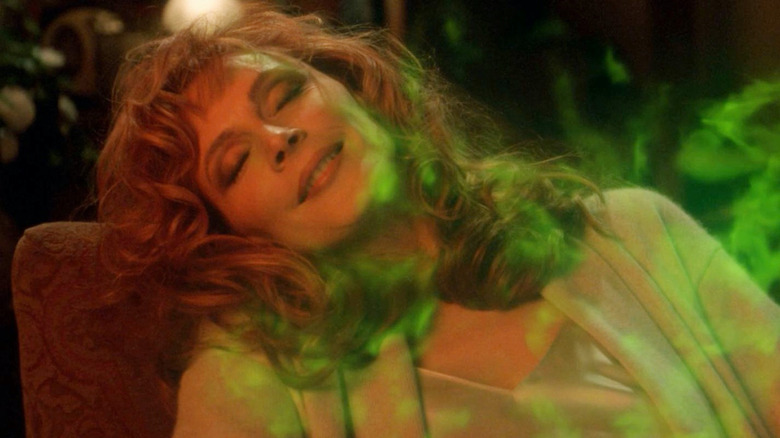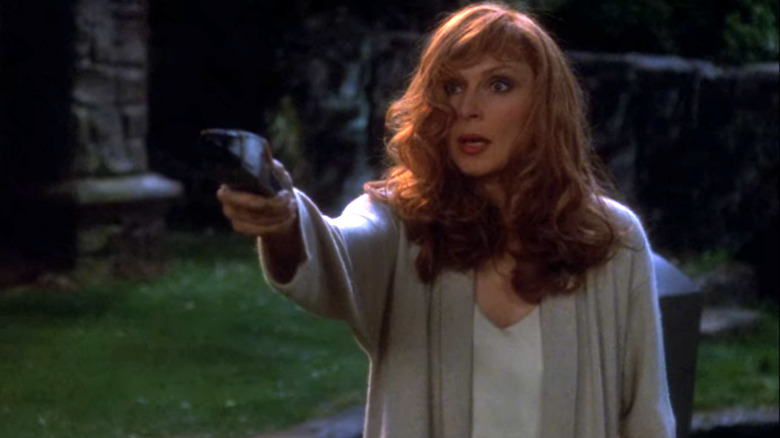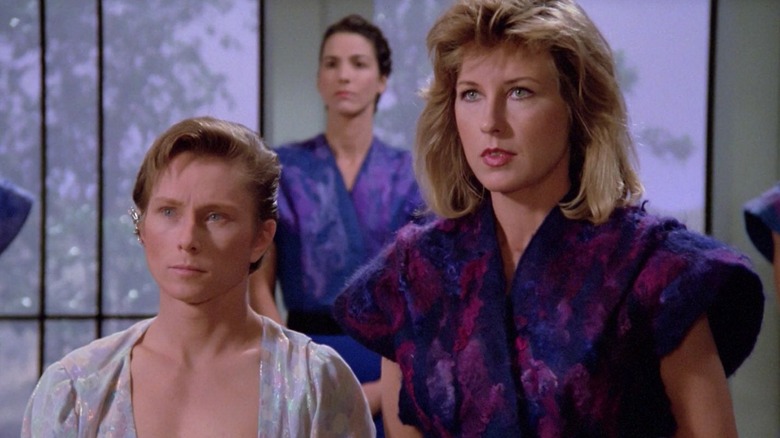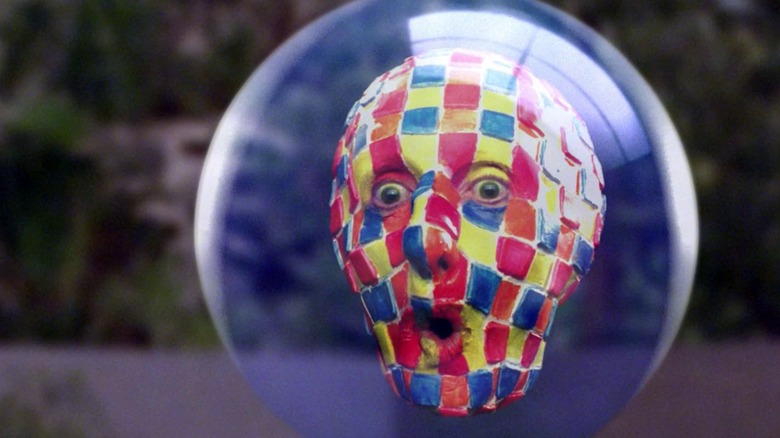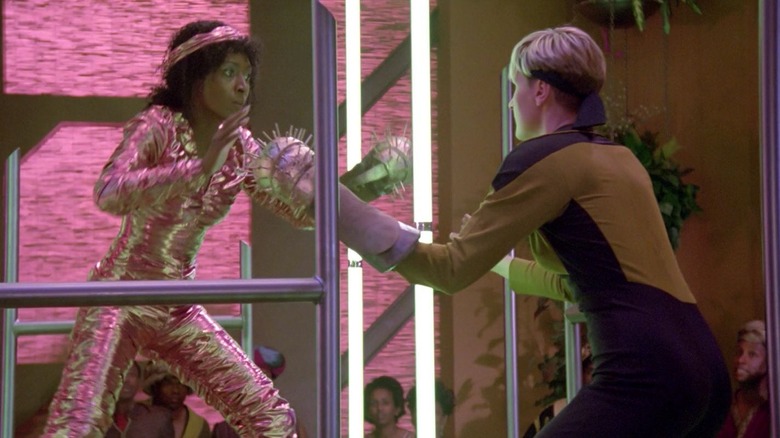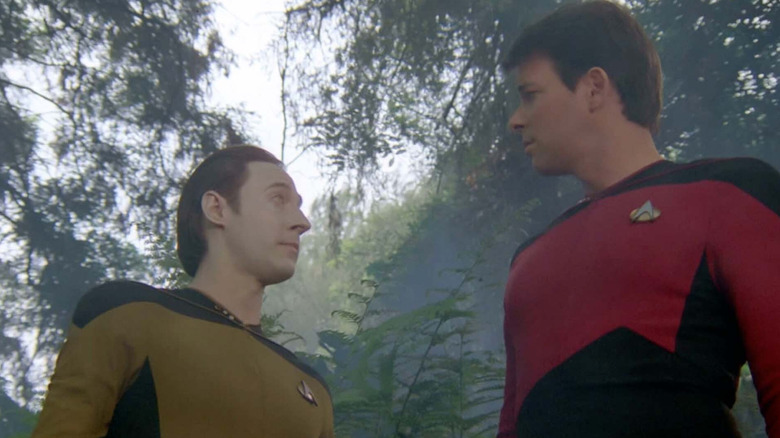The 5 Worst Episodes Of Star Trek: The Next Generation, Ranked
In the eyes of Trekkies, "Star Trek: The Next Generation" may be the greatest TV series of all time. No other show — not "The Sopranos," not "M*A*S*H," not "Manimal" — has come close to the high quality and rich premise of the adventures of the Enterprise-D in the 24th century. Famously, creator Gene Roddenberry took core concepts from his 1966 "Star Trek" series and enhanced them for "The Next Generation," creating an even more aggressively utopian world that was even more forthright about its anticapitalist, anticolonialist intentions. He even instigated a rule among the show's writers that no two characters were allowed to bicker, and no stories could stem from interpersonal conflicts. In Roddenberry's vision, everyone got along at all times.
Writers, naturally hated this idea, as they felt conflict is the best way to create drama. For the first two seasons, Roddenberry, writers, and lawyers all butted heads over the series. It's no wonder that most of the show's worst episodes come from those first two seasons.
Of course, "The Next Generation" had its fair share of stinkers, producing some horribly written, contrived, sexist, racist, or just plain obnoxious episodes. The bad episodes, especially after season 2, are few and far between, but they are certainly not absent. In many cases, one can practically picture the show's writers banging their heads against the wall, trying to come up with something filmable under a deadline.
And we Trekkies always noticed when it was crunch time. As much as we love "Star Trek," we also tend to be its harshest critics, happy to point out plot errors, canonical inconsistencies, or bad character choices to anyone willing to listen. In that spirit, here are the five worst episodes of "Star Trek: The Next Generation," ranked from least-worst to, er, most-worst.
5. Sub Rosa
In "Sub Rosa" (January 31, 1994), Dr. Crusher (Gates McFadden) goes to the planet Caldos IV to attend her grandmother's funeral. Her grandmother, Felisa (Ellen Albertini Dow), lived in a quaint Irish cabin with, Crusher is shocked to learn, a 34-year-old live-in lover named Ronin (Duncan Regehr). Ronin, however, is said to be a ghost (!) who can only appear to corporeal beings if someone lights an ancient candle. Dr. Crusher, acting under Ronin's ghostly influence, lights the candle and a man from the cover of a Harlequin romance novel appears. He says he's in love with Dr. Crusher and implores that she leave the Enterprise.
There are multiple scenes in "Sub Rosa" wherein McFadden, possessed by a green ghostly cloud, writhes around in ecstasy. There is also a scene later in the episode wherein Geordi (LeVar Burton) and Data (Brent Spiner) exhume Felisa's corpse, only to witness her springing back to life and attacking them with green lightning. The idea of haunted candles, amorous ghosts, and lighting-imbued gramma corpses would have been fine elements to include in a Full Moon horror movie from 1986, but in "Star Trek," it feels absurd and odd The episode then tries to use sci-fi to explain all the weird haunting crap by stating that Ronin was an anaphasic alien and that the candle was his energy recepticle. Um ... okay.
"Sub Rosa" is also bad because the ordinarily stalwart Dr. Crusher is so easily manipulated by a man in a leather vest. Dr. Crusher can pursue whatever personal life she wants, but one would hope she'd be wiser than to boink a creepy candle ghost.
4. Angel One
Also known as "the sexist one," the episode "Angel One" (January 25, 1988) takes place mostly on the titular planet, which, it is explained, is a matriarchal society. The women occupy the seats of power, whereas men — physically smaller and weaker in this species — tend to serve in servant positions. The leader of Angel One is Beata (Karen Montgomery), who is stingy with the Enterprise-D's requests to search her planet for a crashed ship. Beata eventually agrees to some investigations. However, she demands to canoodle with Commander Riker (Jonathan Frakes) in exchange.
The idea of "Angel One," I think, was to depict a society in which women were in charge, and reveal that it was better run than any ol' patriarchy we might have here on Earth. Or perhaps it was meant as a topsy-turvy metaphor for the mistreatment of women by flipping the script on traditional gender oppression. The problem is that Beata is depicted as horny and unwise, while Angel One's matriarchy is intolerant of traditional marriages and men's rights. It feels gross, self-pitying, and ultimately, yes, sexist.
"Angel One" also reeks of Gene Roddenberry's tendency to create male fantasy scenarios in space. A planet of sexually assertive women who want to pluck and devour the men of their choice? One can grasp how Roddenberry might see that as self-insert fiction.
There is also a subplot about a rampant virus on board the Enterprise, but who cares? I forgot that subplot was part of "Angel One" and I've seen the episode multiple times.
3. Cost of Living
Also known as the "Auntie Mame" episode, "Cost of Living" (April 20, 1992) looks away from the show's main characters to focus on the relationship between Deanna Troi's mother Lwaxana (Majel Barrett) and Worf's son Alexander (Brian Bonsall). Lwaxana is there to marry a stuffed-shirt diplomat she doesn't care about, and keeps eschewing her own wedding prep to spend time with an eight-year-old boy. She takes him into the holodeck where they watch jugglers and bathe in mud (which looks unsettlingly like pudding). The multicolored head in a bubble is played by Dustin Diamond.
Alexander loves spending time with Lwaxana, as she encourages him to break rules and live for the moment. This is horrible advice, given that Counselor Troi (Marina Sirtis) has been working very hard with Worf (Michael Dorn) and Alexander to develop a mutual respect, discipline, and a healthy father/son regard. Lwaxana's advice, for however fun it might sound, is undoing all that.
Lwaxana may be a force of nature in "Star Trek," but here, she's more annoying than anything. One can see her not listening to or giving practical advice, and brushing off her own daughter in favor of ludicrous Cirque du Soleil shows. The episode meanders through a miasma of bad parenting and ultimately says that it's okay to loosen up sometimes, parenting be damned. Then there are the multiple scenes of Lwaxana in a mud bath with Alexander, which are simply unpleasant. In the future, it seems, the ultimate luxury is to sit around in a vat of oobleck.
2. Code of Honor
Also known as "the racist one," the episode "Code of Honor" (October 12, 1987) was misguided from the start. In the episode, the Enterprise visits the planet of Ligon II looking for a vaccine, only to encounter a culture devoted to, well, a strict code of honor. They respect physical strength and fighting prowess, and have complex customs devoted to exchanging respect. In early versions of the script, the "Star Trek" writers envisioned the Ligonians as reptilian beings that abide by the rules of feudal Japan. When the episode was finally shot, the Ligonians were all played by Black actors and dressed in a sci-fi version of 1940s tribal African garb.
The visuals and ideas were a throwback to dated Hollywood tropes, and even some of the showrunners hated how it was turning out. The episode's original director was fired partway through production, perhaps because of his decision to make the Ligonians into dated caricatures. "Star Trek," as mentioned, frequently aspires to be anticolonialist, but the old-fashioned costumes force audiences to think of painful depictions of "darkest Africa" in colonialism-forward Hollywood movies from generations ago. Congratulations, "Star Trek," you did the opposite of what you should have been doing.
Additionally, the titular code of honor is based on old notions of sexism, while the plot featured the kidnapping of Tasha Yar (Denise Crosby) because she's pretty. Yar and a Ligonian name Yareena (Karole Selmon) eventually have to fight to the death in a risible cage match that had been seen in multiple episodes of the original "Star Trek." In addition to everything else, "Code of Honor" is a snore.
1. Shades of Gray
"Shades of Gray" (July 17, 1989) served as the "Next Generation" season 2 finale, by which point the show had run out of money. A writers' strike had shortened production on the season, forcing it to top off at 22 episodes instead of the usual 26. Because of this, a lot of the season's scripts suffered and the finale had to find a way to cut some corners.
The solution was that most insulting of endeavors: a clip show. I understand that in the days before streaming, reruns were catch-as-catch-can, and many viewers may not have seen every single episode of "Star Trek: The Next Generation." Nevertheless, trying to pad out an episode with clips from previous episodes still felt cheap. What's more, when scenes were presented out of context like in "Shades of Gray," they wouldn't make sense to the casual viewer anyway. It was misguided and desperate.
The premise of the episode is fine enough: Riker is scratched by an alien planet that gives him a strange virus. He falls into a coma, so Dr. Pulaski (Diana Muldaur) has to stimulate his cerebral activity to keep the virus from reaching his brain. She inserts needles into Riker's skull, causing him to have flashbacks to earlier scenes from the series.
"Shades of Gray" is notorious for its cheapness and it frequently tops lists of the worst "Next Generation" episodes. Having rewatched it recently, it doesn't emerge any better than it did in 1989. It's still just a clip show. What's more, the acting is terrible, with every character playing up every scene to the extreme, forcing the episode into a melodramatic territory that almost feels like parody. This is nobody's favorite episode for one basic reason: it sucks.
